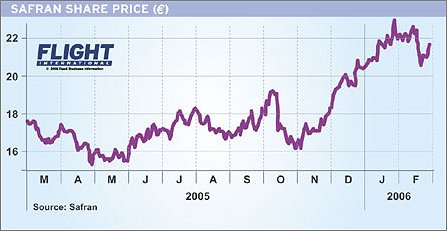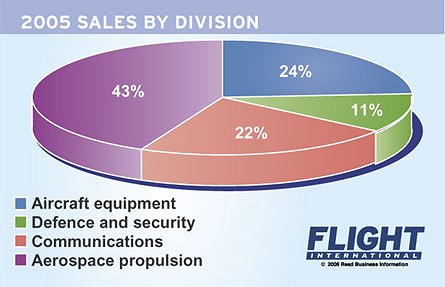The surge in Airbus and Boeing narrowbody orders and deliveries has helped power a strong performance from Safran, the French aerospace and communications giant created almost a year ago by the unlkely merger of Snecma and Sagem.
But there remain doubts over whether the merger itself is delivering the efficiencies promised at the time, or whether the robust results are a simply a result of the upswing in the market and would have happened anyway had the two entities remained separate.
|
Announcing the group’s first full year results last week, chief executive Jean-Paul Béchat claimed the marriage between Snecma’s aircraft propulsion and equipment portfolio and Sagem’s defence systems to mobile phones business had been a “success”, despite widespread scepticism from industry watchers at the time. The company had had an “excellent year”, he said.
It was the aerospace and defence sector – about three-quarters of Safran’s revenues – that drove the 9% rise in earnings before interest and tax to €762 million ($900 million) on the back of a 4.7% rise in revenues to €10.6 billion.
The communications chunk of the old Sagem business, which makes mobile phones, photocopiers and fax machines, saw revenues fall 2.6% and dropped into the red. It was the wisdom of combining a consumer electronics business with a group selling aerospace equipment that caused eyebrows to be raised when the merger was announced in October 2004.
One of the brightest performers for Safran was its CFM International joint venture with General Electric, with a record 1,640 orders booked for the CFM56 engine that exclusively powers the Boeing 737 and about half of the Airbus A320 family. Production of CFM56 engines was 10% higher in 2005 at 800 units.
The helicopter market was also buoyant for Safran’s Turbomeca business with an 11% increase in production to 786 engines.
The Aerospace Propulsion division, which makes up almost half of Safran, saw revenues rise 4.1% to €4.49 billion and operating income increase 15.8% to €454 million.
Aerospace Equipment – which includes the former Snecma Group Messier-Dowty landing gear, Labinal wiring and Messier-Bugatti wheels and brakes businesses – also had a good year, with revenues up 13.1% to €2.51 billion and operating income up 26.7% to €209 million. Messier-Dowty made up for some of its disappointment in losing the Airbus A380 main landing gear contract to US rival Goodrich by being chosen to supply the main gear on the Airbus A350. It also began production of components for the Boeing 787 landing gear.
Béchat says winning deals for both the A350 and 787 “demonstrates our position in the market. Competition with our US counterpart will continue but we are happy to have won these contracts.”
|
The former Sagem Defence Security division saw revenues increase 6.3% to €1.23 billion and operating income increase 5.8% to €109 million. Highlights included winning the inertial navigation systems deal for the Airbus Military A400M and a contract to supply the Australian navy with infrared missile tracking systems.
The group continued to be hit by the impact of the dollar exchange rate – with a constant dollar, revenues would have been up by 6.2%, the company says. But Béchat insists that increases in productivity offset the impact of the weak dollar, allowing improved EBIT in 2005, and that the company has good hedging cover as far ahead as 2007.
Although Safran’s share price rose from €17.8 to €21.9 between March last year and 1 March this year one London-based analyst still has doubts about the benefits of the merger because of the limited “manufacturing overlap” between the former Snecma and Sagem operations.
“We remain relatively sceptical about the delivery of the full level of synergies, particularly as some of them appear to be revenue rather than cost synergies,” he says.
Safran has a plan to cut €700 million from its cost base over three years, of which it says €638 million in savings has already been identified.
Safran makes 80% of its sales from the civil market and 64% from Europe. However, the company is heavily targeting the Asia-Pacific market, with its Snecma Services aftermarket business planning centres in China and India. The company said 2005 had seen a “strong rise in spare parts sales”.
HELEN MASSY-BERESFORD / PARIS
Source: Flight International





















